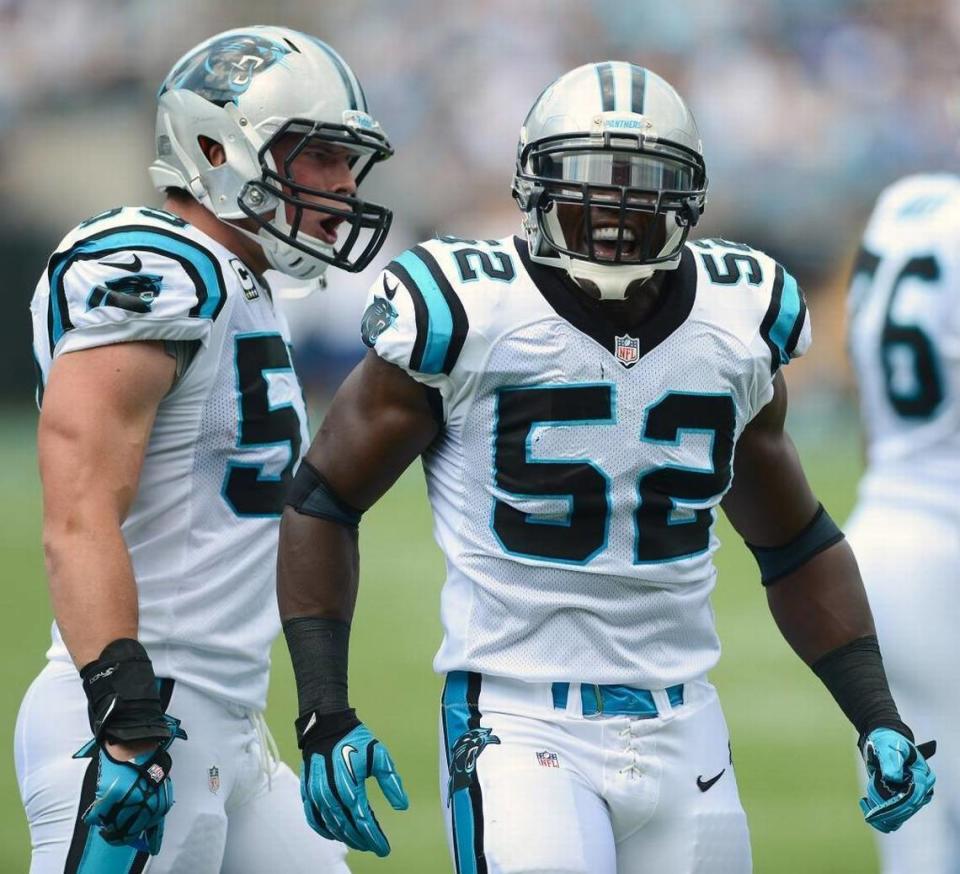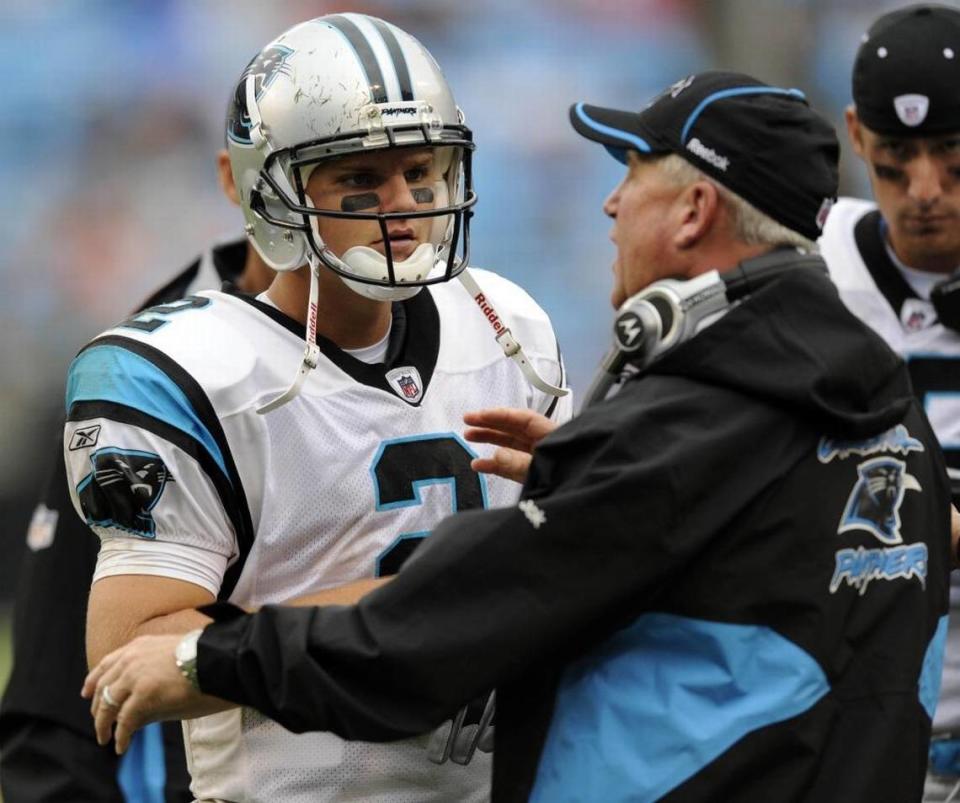Panthers’ 1st draft with a new GM. What 3 changes to expect without Marty Hurney
- Oops!Something went wrong.Please try again later.
- Oops!Something went wrong.Please try again later.
The lead-up to the NFL draft is long and full of inaccurate predictions.
This year, there seem to be more unknowns than unusual. That’s partly due to factors like inconsistency in getting medical concerns checked out and teams having mixed feelings about players who opted out during their final college seasons.
Another element to that is first-year general managers. Carolina Panthers GM Scott Fitterer is one of seven in the role with a new team this year, and several of the other teams pick in the top 15 — Atlanta Falcons, Detroit Lions, Denver Broncos.
This will also be the first year that coach Matt Rhule will undergo a normal draft process with in-person meetings taking place with scouts and coaches at Bank of America Stadium. Last year, former general manager Marty Hurney and Rhule met virtually while deciding last year’s draft class.
“I was saying to like a couple of our scouts the other day, this is the first time I’ve really sat in draft meetings with them,” Rhule said. “Last year, they had their meetings, then we went to the Senior Bowl together and then everything just kind of evaporated (with COVID).”
Hurney, now in Washington, was a part of 18 of the Panthers’ 26 drafts in franchise history through his time with the team, including two stints as general manager.
Fitterer will certainly bring some influence from his Seattle Seahawks background, where he served in a variety of roles in the personnel department since 2001, but not everything. For example, he and Rhule are the lead decision-makers now. The Seahawks are known for taking cornerbacks with 32-inch arms, however, Fitterer said that would not dictate the Panthers’ decision-making necessarily in the same way. What changes could we see and what could stay the same?
Trading back
It has been widely documented that the Seahawks are known for trading back in the first round of the draft, a practice that Fitterer is primed to bring with him to Carolina. Prior to last year, Seattle had traded every first-round pick since 2012. The Seahawks even traded back in the second round in 2020 with the Panthers, which allowed Carolina to acquire Jeremy Chinn.
The Seahawks, however, were typically picking in the back half of the first round, which meant the players with first-round grades were largely already selected.
The Panthers have been public about interest in trading back from the No. 8 pick this year, with Fitterer sharing last week that they had conversations with at least five teams about doing so. The team only has first-round grades on about 16 players, per Fitterer, so they will only want to move back to a certain point or the top players could be gone.
If the trade back comes to fruition — the offer has to be right — it would be the first time the Panthers will have traded back in the first round since 2007, when Hurney sent the No. 14 pick to the New York Jets, who selected Darrelle Revis, and the Panthers moved back to No. 25. It all worked out OK, with Carolina selecting Jon Beason with that pick.

Dave Gettleman, Panthers general manager from 2013-17, is known for never moving back in the first round, so that accounts for much of the recent drafts. However, Hurney also largely chose to stay put. Twice in a row, he traded away first-round picks (2009 and 2010), and later said he learned from those trades for his second stint with the Panthers.
Hurney did have success with his picks in the first round. Eight of the Panthers’ 10 first-rounders from 2002 to 2012 became Pro Bowlers. The other two were cornerback Chris Gamble, a nine-year starter, and Jeff Otah, whose career ended after knee issues.
The picks from 2018 to 2020 — DJ Moore, Brian Burns and Derrick Brown — have yet to make the Pro Bowl.
Second-round success?
Despite his success in the first round, Hurney often struggled with the picks that followed (cough, Jimmy Clausen).
From 2002-12, he drafted 11 players in the second round, only five of whom became multi-year starters. Only one — center Ryan Kalil — went to the Pro Bowl. In his second stint, Hurney drafted cornerback Donte Jackson, left tackle Greg Little, defensive end Yetur Gross-Matos and Chinn. Time will tell on some of those selections.
Starting in 2012, the Seahawks’ second-round highlights include linebacker Bobby Wagner, wide receiver Paul Richardson, defensive end Frank Clark, defensive tackle Jarran Reed and center Ethan Pocic, all of whom developed into consistent starters. There are some misses as well, especially as of late, but the success is undoubtedly there.
Fitterer also noted last week the depth of the players that will be available early on Day 2.

Quarterback competition
Drafting a quarterback is a possibility for the Panthers, even though the team just invested highly in Sam Darnold. The organization is interested in Ohio State quarterback Justin Fields, as The Observer has reported, but a lot has to happen for him to be there at eighth overall, and if he is, other teams would likely be interested in trading up (see above).
The Seahawks have had an approach of going all-in on quarterbacks. Just prior to drafting Russell Wilson in the third round in 2012, Seattle had signed Matt Flynn to a big free-agent deal — three years, $19.5 million. Once WIlson was the clear starter, the team continued to heavily scout quarterbacks throughout the years, something Fitterer has said he’ll do each offseason.
“We’ll continue to look at quarterbacks,” Rhule said this month. “I’ve been impressed, going around and watching some of these guys throw. We’ll look at anything and everything.”
Hurney, on the other hand, rarely invested highly in drafting quarterbacks. Signing free agents like Jake Delhomme was more of the approach, especially with coach John Fox preferring older quarterbacks. During Hurney’s term as general manager, the team only invested in a quarterback in the first two rounds twice, despite the importance of the position — Clausen and then Cam Newton No. 1 overall the following year.
The Panthers have not been secretive about the desire to get the quarterback position right. Having two players on rookie contracts is a possibility.
Trades in general
This won’t be new for the Panthers. Hurney often traded back and up throughout the draft. Fitterer and Rhule seem primed to do the same, especially moving back later in the draft, if appropriate to acquire more picks this year and in the years to come.
Hurney traded a draft pick — up or down — in every year as general manager except 2011. That trend should continue this year.

